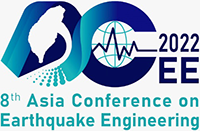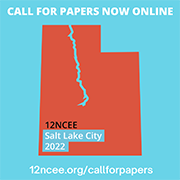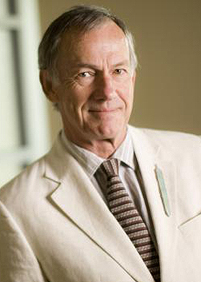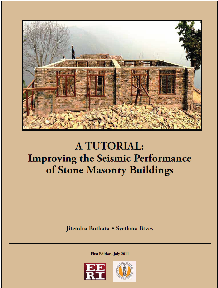A worldwide compilation of earthquakes and their magnitudes, losses, and references for information from ancient times to the near present.
https://www.ngdc.noaa.gov/...Up to the minute reports of worldwide earthquakes, with maps, estimates of affected local area, seismological information, and other data. http://earthquake.usgs.gov/
http://earthquake.usgs.gov/Reconnaissance reports from recent earthquakes.
http://www.eeri.orgOn behalf of the Canadian Association for Earthquake Engineering (CAEE), I am pleased to invite you to join us at the joint Canadian-Pacific Conference on Earthquake Engineering (https://ccee-pcee.ca/), which will be held in Vancouver, BC, from June 25-30, 2023. This is the first time the Canadian Conference on Earthquake Engineering is being held jointly with the Pacific Conference on Earthquake Engineering, and we are excited to exchange ideas from across Canada, New Zealand, and around the Pacific Rim as we seek to develop a society that is more resilient in the face of earthquake threats.
The technical program will explore the latest advances in structural and geotechnical earthquake engineering, seismology, social science and public policy related to earthquakes, and more. With exciting keynote addresses and special sessions, we will deepen and broaden our understanding of this field that we all care so much about.
We are also eager to show you the best of Vancouver, one of the world's most beautiful and friendly cities. Reconnect with old friends and make new connections in a setting that is second-to-none.
The deadline for abstract submission for CCEE-PCEE has been extended until February 10, 2023
CCEE - PCEE Secretariat
- IAEE Central Office
The IAEE is pleased to announce that the following individuals have been selected as the IAEE Officers. The Executive Committee (EC) of the IAEE convened (in a remote mode) on September 14, 2022. The Officers will try their best for the sustainable development of the IAEE and wish to ask for your most kind cooperation with us.
Officers:
Farzad Naeim, President (United States of America)
Masayoshi Nakashima, Past President (Japan)
Hiroe Miyake, Secretary General (Japan)
- IAEE Central Office
The papers presented at the 17th World Conference on Earthquake Engineering in Sendai, Japan, are posted online (https://www.nicee.org/wcee/). The 17th WCEE provided a unique opportunity to establish synergies between participants from different engineering areas and from such varied fields as earth sciences, economics and social sciences, and contributed to a global effort of the scientific and technical community towards a safer world in regard to the earthquake risk.
All of the papers in the World Conference on Earthquake Engineering Proceedings from the first WCEE in 1956 to present have been digitized by the National Information Centre of Earthquake Engineering at the Indian Institute of Technology in Kanpur.
Special thanks go to a digital archiving project of the WCEE proceedings.
- IAEE Central Office
The 10th European Workshop on the Seismic Behaviour of Irregular and Complex Structures (10EWICS) will take place, under the auspices of EAEE WG8 ‘Seismic Behaviour of Irregular and Complex Structures’, on 5-6 October 2023 in Catania (Italy). The Workshop aims at providing an international platform to discuss, exchange ideas, and gain new insights in the research field of irregular and complex structures, framed in a convivial atmosphere in which to make new contacts and renew old friendships. The topics of the Workshop have been constantly updated, enlarging the original set with new emerging topics. The deadline for the abstract submission is October 16th 2022. For more information please see the first circular below.
- IAEE Central Office
 The 8th Asia Conference on Earthquake Engineering (8ACEE) will be held in Taipei, Taiwan, ROC, from November 9-11, 2022, with the theme “Earthquake-Resilient and Sustainable Communities.” Due to the COVID-19 pandemic, 8ACEE is being organized as a hybrid conference comprising “on-site” and “online” events. The venue for the on-site meeting is the recently remolded office building of Taiwan’s National Center for Research on Earthquake Engineering (NCREE). The registration and paper submission have been opened! The first and only submission will be a 4-to-8 page manuscript.
The 8th Asia Conference on Earthquake Engineering (8ACEE) will be held in Taipei, Taiwan, ROC, from November 9-11, 2022, with the theme “Earthquake-Resilient and Sustainable Communities.” Due to the COVID-19 pandemic, 8ACEE is being organized as a hybrid conference comprising “on-site” and “online” events. The venue for the on-site meeting is the recently remolded office building of Taiwan’s National Center for Research on Earthquake Engineering (NCREE). The registration and paper submission have been opened! The first and only submission will be a 4-to-8 page manuscript.
8ACEE aims to provide an excellent forum to bring together researchers, professionals, engineers, and academics to promote and exchange new ideas and experiences in the fields of earthquake engineering, disaster management, seismic risk reduction, and many other related research fields.
For more information, please visit http://8acee.ncree.org.tw.
- IAEE Central Office
The 5th International Conference on Earthquake Engineering and Disaster Mitigation (ICEEDM) 2022 will be delivered in a hybrid event format, combining an in-person conference with a virtual online component. Participants for in-person conference are limited to 100 people, while online participants are not limited. Please see the leaflet provided below for the details
- IAEE Central Office
During 17WCEE, in collaboration with JAEE, the Japan Association for Earthquake Engineering, IAEE organized two brainstorming sessions on future directions of earthquake engineering. The sessions took place in a hybrid mode, which permitted online participation from around the globe. The two IAEE brainstorming sessions are summarized in the followng report.
https://www.iaee.or.jp/pdf/Brainstorming_Sessions Report_for_IAEE_Webpage_20211223.pdf
We are pleased to announce that the first series of "CSI/IAEE Master Series" during 17WCEE is now archived on our website. The new page provides access to the pdf versions of the monographs for "Read the Masters" and the keynote videos for "Meet the Masters".
https://www.iaee.or.jp/MastersSeries.html
- IAEE Central Office
The IAEE is pleased to announce that the following distinguished scholars have been awarded IAEE honorary membership for their outstanding contribution to earthquake engineering and earthquake disaster mitigation. The General Assembly (GA) of the IAEE convened (in a remote mode) at the Seventeenth World Conference on Earthquake Engineering (17WCEE) and unanimously decided to award the six scholars. The IAEE wishes all the best for their continued work and their mentorship to the next generations.
Peter Fajfar (Europe, Structural Earthquake Engineering, IAEE Director 2004-12, Read-the-Masters 2020)
Sudhir Jain (South Asia, Structural Earthquake Engineering, IAEE President 2014-18)
Jim Jirsa (North America, Structural Earthquake Engineering, Concrete structures, Meet-the-Masters 2020)
Steve Kramer (North America, Geotechnical Earthquake Engineering)
Shunsuke Otani (Asia/Oceania, Structural Earthquake Engineering, IAEE Director 2008-12)
Rodolfo Saragoni (South America, Geotechnical Earthquake Engineering, Chairman of Organizing Committee, 16WCEE)
- IAEE Central Office
The IAEE is pleased to announce that the following individuals have been selected as the IAEE Officers and Directors. The General Assembly (GA) of the IAEE convened (in a remote mode) at the Seventeenth World Conference on Earthquake Engineering (17WCEE) and voted for those positions.
We, the Officers and Directors, will try our best for the sustainable development of the IAEE and wish to ask for your most kind cooperation with us.
Officers:
- Masayoshi Nakashima, President (Japan)
- Farzad Naeim, President Elect (United States of America)
- G. Michele Calvi, Executive Vice President (Italy, until 2024)
- Koichi Kusunoki, Secretary General (Japan)
* The current term lasts until 2022 unless indicated otherwise.
Directors:
(Second term Directors)
- Svetlana Brzev (Serbia, Structural Engineering)
- Dina D’Ayala (UK, Structural Engineering)
- Ken Elwood (New Zealand, Structural Engineering)
- Otton Lala (Ecuador, Structural Engineering)
- Ellen Rathje (USA, Geotechnical Engineering)
(First term Directors)
- Sinan Akkar (Turkey, Engineering Seismology)
- Sergio Alcocer (Mexico, Structural Engineering)
- Ioannis Anastasopoulos (Switzerland, Geotechnical Engineering)
- Stavroula Pantazopoulou (Canada, Structural Engineering)
- Durgesh Rai (India, Structural Engineering)
- Tao Wang (China, Structural Engineering)
* For both the second and first term directors, the current term lasts until 2024. The first term directors may serve for another term after 2024.
- IAEE Central Office
IAEE is delighted to announce that Milano, Italy, is the venue of Eighteenth World Conference on Earthquake Engineering (18WCEE). The IAEE's National Delegates voted and has chosen Italy (Milano) in November 2020.
Please see the link below : A Message from IAEE President, A Message from Italy
Link
- IAEE Central Office
IAEE wishes to announce that we will organize the first series of events for the “Masters Program” during 17WCEE.
- IAEE Central Office

The Call for Papers for the 12th National Conference on Earthquake Engineering (12NCEE) is now open! Special session proposals are due September 10, and papers are due October 15. Please note that there will be no preliminary abstract submission and review for papers?the first and only submission will be a 4-page paper manuscript.
NCEE is a milestone conference hosted by the Earthquake Engineering Research Institute (EERI) every four years. 12NCEE will convene from June 27-July 1 2022 in downtown Salt Lake City, Utah. The conference will bring together professionals from a broad range of earthquake-relevant disciplines, providing an opportunity for researchers and practitioners to share the latest knowledge and techniques to better understand and mitigate the damaging effects of earthquakes and tsunamis. Timely and relevant lessons from the COVID-19 pandemic are also expected. A limited number of registration grants will be available for students, early-career academics, and early-career professionals. For more information, visit https://12ncee.org
- IAEE Central Office
IAEE has launched a new initiative named “Masters Program”. Motivation for the initiative is for IAEE to serve as “Connection” among the past, present, and future of earthquake engineering and to secure the transfer of knowledge across generations.
In “Masters Program”, the following three events: “Read the Masters”, “Meet the Masters”, and “Greet the Masters” are organized. The concept is to connect legendary figures in the world of earthquake engineering with contemporaries. All three events are to be organized in tune with World Conference on Earthquake Engineering (WCEE), and we are pleased to announce that the inaugurating events will be programed into 17WCEE to be held in Sendai, Japan, during September 13 and 18, 2020. (wcee website).
Please see the link below for details of “Masters Program”
Link
- IAEE Central Office
- IAEE Central Office
Indonesian Earthquake Engineering Association (IEEA), Andalas University, and Bandung Institute of Technology will be organizing the 4th International Conference on Earthquake Engineering and Disaster Mitigation on 26-27 September, 2019 in Padang, Indonesia.
Please see the conference website for further information.
http://conference.ft.unand.ac.id/index.php/iceedm/2019
- IAEE Central Office
- IAEE central office and Dr. Carlos Zavala
The Universidad Nacional de Cuyo in Argentina and the Earthquake Engineering Research Institute (EERI) have published a Spanish translation of the oral history of the late Professor Vitelmo Bertero.
The translated oral history is available from the link below:
- IAEE Central Office
- Masayoshi Nakashima, President
-Bob Reitherman
Chair, EERI Oral History Committee
- IAEE Central Office
- IAEE Central Office
- IAEE Central Office
- IAEE Central Office
- IAEE Central Office
- IAEE Central Office
- IAEE Central Office
- IAEE Central Office
- IAEE Central Office
- IAEE Central Office
- IAEE Central Office
- IAEE Central Office
NARLabs, an independent non-profit institute consisted of several national laboratories in Taiwan, summarized a brief report of the earthquake and the resulting damage.- IAEE National Delegate, Prof. Shyh-Jiann Hwang of National Taiwan University
THE IAEE AT FIFTY: A Brief History of the International Association for Earthquake Engineering By Polat Gulkan and Robert Reitherman, September 2012
But disaster pursues us. It pursues us with a step as steady as time, and an appetite as keen as death.
- Lord Beaverbrook
CONTENTS
Acknowledgments
1. Introduction
2. A Half-Century of Perspective
3. Seismic Safety: Our Common, Elusive Goal
4. An Overview of the Establishment and Development of IAEE
5. World Seismic Safety Initiative (WSSI) and Other Global Programs
6. The World Conferences on Earthquake Engineering
7. Conclusion
Appendix 1
Prehistory of IAEE (1960 through 1963)
Appendix 2
Officers of IAEE from 1963
Appendix 3
Member Countries of IAEE as of 2012
Link to PDF file
Indonesian Earthquake Engineering Association (IEEA) and Udayana University (UNUD)-Bali hold the 3rd International Conference on Earthquake Engineering and Disaster Mitigation on 1-2 August, 2016 in Bali, Indonesia.
Please check the leaflet below for the first annuncement and call for abstracts.
the 3rd International Conference on Earthquake Engineering and Disaster Mitigation
- IAEE Central Office
- IAEE Central Office

One of earthquake engineering's leading lights of the past several decades, Nigel Priestley, has passed away. The notice from the New Zealand Society for Earthquake Engineering is reproduced here. It is with deep sadness that I inform you Professor Nigel Priestley passed away peacefully on Tuesday December 23, 2014 in Christchurch, surrounded by his wife and children, after a long battle with cancer. Nigel revolutionised the design of structures to resist earthquakes and made everlasting impact on the higher education for earthquake engineers in NZ, US and Europe. Nigel received numerous honours for his immense contribution to the science and art of Earthquake engineering. Amongst these, it include honorary doctorates from ETH, Zurich and Cujo Argentina; Nigel was a Distinguished Fellow of IPENZ, Fellow of the Royal Society of New Zealand, an Officer of the New Zealand Order of Merit (ONZM), and a Life Member and a past President of the Society (1985-1986).
- Gregory MacRae, IAEE National Delegate of New Zealand, with much help from friends and colleagues in New Zealand and elsewhere
The International Association for Earthquake Engineering (IAEE) was established in February 1963 with its Central Office in Tokyo. The IAEE aims to promote international cooperation among scientists and engineers in the field of earthquake engineering through interchange of knowledge, ideas, and results of research and practical experience. The aim has been achieved mainly by holding the World Conference on Earthquake Engineering (WCEE) every four years. The most recent 15th WCEE was held in Lisbon, Portugal in 2012. The 15th WCEE attracted more than 3,000 participants from all over the world. And the 16th WCEE will be held in Santiago, Chile, in January, 2017. I believe that this web site will increase visibility and recognition of the IAEE within the global engineering and scientific communities as well as within non-technical communities.
- Koichi Kusunoki, Secretary General, IAEE
Following a formal application for membership by la Asociacion Costarricense de Ingenieria Estructural y Sismica (ACIES), the IAEE Executive Committee has resolved to accept Costa Rica as its newest Member Country. We welcome our Costa Rican colleagues into the Association. With this addition, IAEE now has reached 58 members.
- IAEE Central Office
It has now been two years since the occurrence of what has turned out to be one of the deadliest and most costly natural disasters ever witnessed in the world. The M9 mega-event that shook the northeastern seaboard of Honshu Island, where the nearest major city is Sendai, ranks among the largest seismic events that have been recorded. The earthquake unleashed a major tsunami that swept across many smaller fishing settlements along the Tohoku coastline, and exacted a human loss toll that stands in excess of 18 000 with many injured. A series of seemingly unlikely equipment failures at the Fukushima Daiichi nuclear plant led to multiple meltdowns and releases of radioactive materials into the environment following the earthquake and tsunami.
The scale of the disaster beggars description in terms also of economic losses. While performance of building systems, railway networks and early warning equipment for lifelines was good, many images of death and destruction brought by the tsunami were etched into the memory of everyone in the world. The Japanese people bore the tragedy with fortitude, and have gained the respect of other countries that must live within the shadow of the seismic threat because of the many individual tales of communal spirit and selfless solidarity.
This disaster must serve as a call for sustained vigilance and unflagging preparedness to protect lives and assets against the seismic hazard. The Hyogo Framework for Action (HFA) against natural disasters and their harmful effects was crafted in 2005 in Japan ten years after the Kobe earthquake to serve as the blueprint for risk reduction policies that governments must adopt and enforce. The International Association for Earthquake Engineering (IAEE) was among professional organizations that contributed to the preparation of HFA, and through its member national organizations, has been among the principal mechanisms for implementing the guiding principles that it has outlined.
We respectfully commemorate the memory of victims of the March 11, 2011 Japan earthquake with bowed heads, and pledge to pursue the objectives of IAEE in ensuring a safer world for all those who stand in danger of the seismic peril.
- Officers and Executive Committee Members of IAEE

We are deeply grieved to inform the international community of earthquake engineers that Professor Sheldon Cherry, Professor Emeritus of Civil Engineering, University of British Columbia, Vancouver, has passed away on March 23, 2014, a few days short of his 86th birthday. Professor Cherry's service to IAEE was as follows: Director (1973-1980), President (1996-2002), Honorary Member (from 2004). [move page]

Nicholas Neocles Ambraseys (1929-2012) was one of the towering figures of engineering seismology, who played a key role in the development of the discipline for more than half a century - from before the foundation of the IAEE in 1963 (he attended the committee meetings in 1960 that led to its establishment) right up to the time of his death at his London home on 28th December. [move page]
National organizations from the following countries have endorsed to the IAEE declaration.
Algeria, Argentina, Australia, Austria, Bangladesh, Canada, Chile, China, Colombia, Costa Rica, Croatia, France, Germany, Greece, Israel, Japan, Korea, Macedonia, Mexico, Nepal, New Zealand, Norway, Peru, Portugal, Romania, Russia, Singapore, Spain, Switzerland, Chinese Taiwan, Thailand, Turkey, Ukraine, USA and Venezuela
hat seven scientists who were members of the National Commission for the Forecast and Prevention of Major Risks have been sentenced to prison terms for having provided "inaccurate, incomplete and contradictory" information about the danger of the minor tremors felt ahead of 6 April 2009 M6.3 earthquake, leading to the deaths of some 300 persons in and around the historic town of L'Aquila in central Italy.
While we have not examined the wording of the court's decision we must take a stand on what we believe is a flawed judgment that might have a negative impact for the future. Earthquake science is not a magical tool that allows anyone to state with any degree of credible reliability when and where an earthquake with a prescribed size will occur because earthquake occurrence does not conform to a simple and coherent pattern. The interpretation of minor foreshocks to state whether they herald a major earthquake to follow has yet never been done, except in the imagination of publicity seekers with no scientific credentials or on account of pure coincidence. The seven defendants are all well known in their respective professional fields, and enjoy the respect of their peers. We feel that justice has been poorly served, and a dangerous precedent has been established with the verdict. No responsible scientist will henceforth dare to risk his or her professional reputation (not to mention personal well-being) by interpreting signals of activity from volcanoes or possible effects of hurricanes. Forces of nature usually do not lend themselves to easy forecasts, and most are inherently unpredictable.
The communication of risk to the public in a way that it can be easily understood is one of the most difficult challenges facing science and technology. The loss of life that occurred in L'Acquila was tragic and regrettable, but that is attributable to many other causes besides the statement undersigned by the defendants,and the variability of the ground motions that attacked those buildings. The aftermath must not be allowed to turn into a spectacle calling for false culprits to punish in the interest of appeasing the public outrage. Instead, we must draw the right lessons so that there will be no victims in the future in this type of a preventable disaster.

Authored by Jitendra Bothara of New Zealand and Svetlana Brzev of Canada, the tutorial focuses on traditional stone masonry dwellings primarily in the earthquake-prone countries of Asia, explains the underlying causes for their poor seismic performance
and offers techniques for improving both new and existing buildings. A pdf version of the tutorial is available at the World Housing Encyclopedia
website:
http://www.world-housing.net/tutorials/stone-tutorials
The production of the tutorial was a collaborative effort among EERI, the New Zealand Society for Earthquake Engineering and the Earthquake Engineering Center of the University of Engineering and Technology, Peshawar, Pakistan.
The Bureau for Crisis Prevention and Recovery of the United Nations Development Programme has printed copies of the tutorial for distribution through their program in Asia. The publication will be shared with UNDP country offices, national governments' disaster management ministries and offices, and used in training programs. EERI and the National Information Centre of Earthquake Engineering (NICEE) at the Indian Institute of Technology Kanpur have copies available for the cost of shipping and handling. EERI shipping rates are: $10 to the U.S., $15 to Canada and Mexico, and $20 to other countries. Please contact NICEE (nicee.org) to order the publication from them.
the World Housing Encyclopedia is a joint project of EERI and IAEE. More information is available at the project website: www.world-housing.net.


A fellowship fund has been established in the name of Joseph Penzien to fund and support graduate engineering students enrolled in the Department of Civil and Environmental Engineering at the University of California, Berkeley. Preference will be given to students who have demonstrated financial need and have chosen the field of structural engineering and structural mechanics. The goal is to raise $500,000 to qualify for a named graduate fellowship.
To make a contribution, please send cash/checks to Enid C. Pollack, Sr. Development Director at UC Berkeley College of Engineering, 210 McLaughlin Hall, College of Engineering, Berkeley, CA 94720-1722. Please make checks payable to UC Berkeley College of Engineering and include check memo: Joseph Penzien Memorial Fund. Ms. Pollack can be contacted by phone at 510-642-2257 or by email at epollack@berkeley.edu.
All of the papers in the World Conference on Earthquake Engineering Proceedings from the first WCEE in 1956 to present have been digitized by the National Centre of Earthquake Engineering at the Indian Institute of Technology in Kanpur
Papers from all of the World Conferences can be accessed at:
https://www.nicee.org/wcee/index2.php